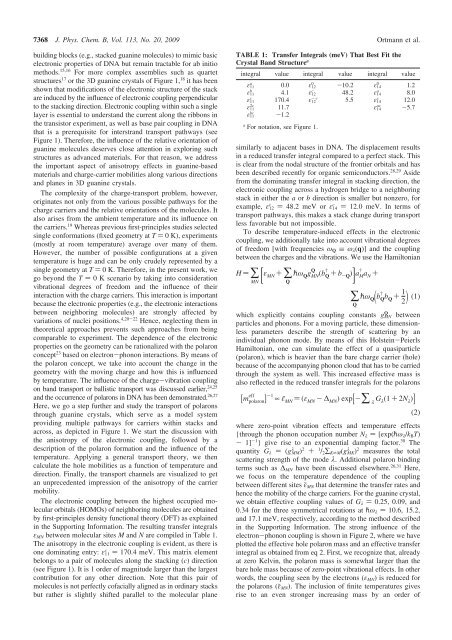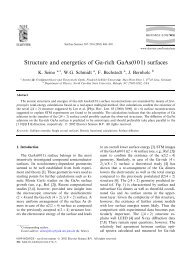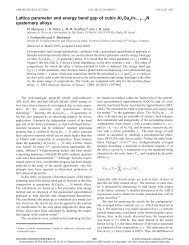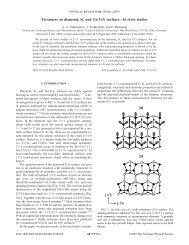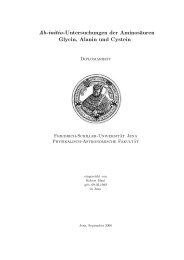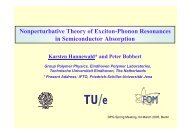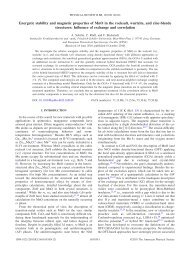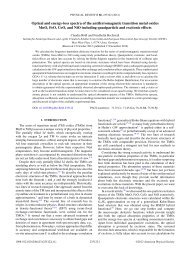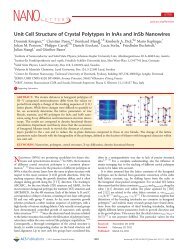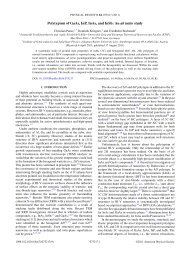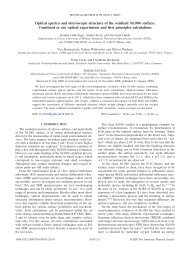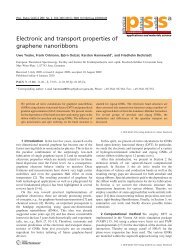Charge Transport in Guanine-Based Materials - Institut für ...
Charge Transport in Guanine-Based Materials - Institut für ...
Charge Transport in Guanine-Based Materials - Institut für ...
Create successful ePaper yourself
Turn your PDF publications into a flip-book with our unique Google optimized e-Paper software.
7368 J. Phys. Chem. B, Vol. 113, No. 20, 2009 Ortmann et al.<br />
build<strong>in</strong>g blocks (e.g., stacked guan<strong>in</strong>e molecules) to mimic basic<br />
electronic properties of DNA but rema<strong>in</strong> tractable for ab <strong>in</strong>itio<br />
methods. 15,16 For more complex assemblies such as quartet<br />
structures 17 or the 3D guan<strong>in</strong>e crystals of Figure 1, 18 it has been<br />
shown that modifications of the electronic structure of the stack<br />
are <strong>in</strong>duced by the <strong>in</strong>fluence of electronic coupl<strong>in</strong>g perpendicular<br />
to the stack<strong>in</strong>g direction. Electronic coupl<strong>in</strong>g with<strong>in</strong> such a s<strong>in</strong>gle<br />
layer is essential to understand the current along the ribbons <strong>in</strong><br />
the transistor experiment, as well as base pair coupl<strong>in</strong>g <strong>in</strong> DNA<br />
that is a prerequisite for <strong>in</strong>terstrand transport pathways (see<br />
Figure 1). Therefore, the <strong>in</strong>fluence of the relative orientation of<br />
guan<strong>in</strong>e molecules deserves close attention <strong>in</strong> explor<strong>in</strong>g such<br />
structures as advanced materials. For that reason, we address<br />
the important aspect of anisotropy effects <strong>in</strong> guan<strong>in</strong>e-based<br />
materials and charge-carrier mobilities along various directions<br />
and planes <strong>in</strong> 3D guan<strong>in</strong>e crystals.<br />
The complexity of the charge-transport problem, however,<br />
orig<strong>in</strong>ates not only from the various possible pathways for the<br />
charge carriers and the relative orientations of the molecules. It<br />
also arises from the ambient temperature and its <strong>in</strong>fluence on<br />
the carriers. 19 Whereas previous first-pr<strong>in</strong>ciples studies selected<br />
s<strong>in</strong>gle conformations (fixed geometry at T)0K), experiments<br />
(mostly at room temperature) average over many of them.<br />
However, the number of possible configurations at a given<br />
temperature is huge and can be only crudely represented by a<br />
s<strong>in</strong>gle geometry at T ) 0 K. Therefore, <strong>in</strong> the present work, we<br />
go beyond the T ) 0 K scenario by tak<strong>in</strong>g <strong>in</strong>to consideration<br />
vibrational degrees of freedom and the <strong>in</strong>fluence of their<br />
<strong>in</strong>teraction with the charge carriers. This <strong>in</strong>teraction is important<br />
because the electronic properties (e.g., the electronic <strong>in</strong>teractions<br />
between neighbor<strong>in</strong>g molecules) are strongly affected by<br />
variations of nuclei positions. 4,20-22 Hence, neglect<strong>in</strong>g them <strong>in</strong><br />
theoretical approaches prevents such approaches from be<strong>in</strong>g<br />
comparable to experiment. The dependence of the electronic<br />
properties on the geometry can be rationalized with the polaron<br />
concept 23 based on electron-phonon <strong>in</strong>teractions. By means of<br />
the polaron concept, we take <strong>in</strong>to account the change <strong>in</strong> the<br />
geometry with the mov<strong>in</strong>g charge and how this is <strong>in</strong>fluenced<br />
by temperature. The <strong>in</strong>fluence of the charge-vibration coupl<strong>in</strong>g<br />
on band transport or ballistic transport was discussed earlier, 24,25<br />
and the occurrence of polarons <strong>in</strong> DNA has been demonstrated. 26,27<br />
Here, we go a step further and study the transport of polarons<br />
through guan<strong>in</strong>e crystals, which serve as a model system<br />
provid<strong>in</strong>g multiple pathways for carriers with<strong>in</strong> stacks and<br />
across, as depicted <strong>in</strong> Figure 1. We start the discussion with<br />
the anisotropy of the electronic coupl<strong>in</strong>g, followed by a<br />
description of the polaron formation and the <strong>in</strong>fluence of the<br />
temperature. Apply<strong>in</strong>g a general transport theory, we then<br />
calculate the hole mobilities as a function of temperature and<br />
direction. F<strong>in</strong>ally, the transport channels are visualized to get<br />
an unprecedented impression of the anisotropy of the carrier<br />
mobility.<br />
The electronic coupl<strong>in</strong>g between the highest occupied molecular<br />
orbitals (HOMOs) of neighbor<strong>in</strong>g molecules are obta<strong>in</strong>ed<br />
by first-pr<strong>in</strong>ciples density functional theory (DFT) as expla<strong>in</strong>ed<br />
<strong>in</strong> the Support<strong>in</strong>g Information. The result<strong>in</strong>g transfer <strong>in</strong>tegrals<br />
ε MN between molecular sites M and N are compiled <strong>in</strong> Table 1.<br />
The anisotropy <strong>in</strong> the electronic coupl<strong>in</strong>g is evident, as there is<br />
c<br />
one dom<strong>in</strong>at<strong>in</strong>g entry: ε 11 ) 170.4 meV. This matrix element<br />
belongs to a pair of molecules along the stack<strong>in</strong>g (c) direction<br />
(see Figure 1). It is 1 order of magnitude larger than the largest<br />
contribution for any other direction. Note that this pair of<br />
molecules is not perfectly cofacially aligned as <strong>in</strong> ord<strong>in</strong>ary stacks<br />
but rather is slightly shifted parallel to the molecular plane<br />
TABLE 1: Transfer Integrals (meV) That Best Fit the<br />
Crystal Band Structure a<br />
<strong>in</strong>tegral value <strong>in</strong>tegral value <strong>in</strong>tegral value<br />
a<br />
ε 11 0.0<br />
0<br />
ε 12 -10.2<br />
0<br />
ε 14 1.2<br />
b<br />
ε 11 4.1<br />
c<br />
ε 12 48.2<br />
a<br />
ε 14 8.0<br />
c<br />
ε 11 170.4<br />
- c<br />
ε 12 5.5<br />
c<br />
ε 14 12.0<br />
2c<br />
ε 11 11.7<br />
ac<br />
ε 14 -5.7<br />
bc<br />
-1.2<br />
ε 11<br />
a For notation, see Figure 1.<br />
similarly to adjacent bases <strong>in</strong> DNA. The displacement results<br />
<strong>in</strong> a reduced transfer <strong>in</strong>tegral compared to a perfect stack. This<br />
is clear from the nodal structure of the frontier orbitals and has<br />
been described recently for organic semiconductors. 28,29 Aside<br />
from the dom<strong>in</strong>at<strong>in</strong>g transfer <strong>in</strong>tegral <strong>in</strong> stack<strong>in</strong>g direction, the<br />
electronic coupl<strong>in</strong>g across a hydrogen bridge to a neighbor<strong>in</strong>g<br />
stack <strong>in</strong> either the a or b direction is smaller but nonzero, for<br />
c c<br />
example, ε 12 ) 48.2 meV or ε 14 ) 12.0 meV. In terms of<br />
transport pathways, this makes a stack change dur<strong>in</strong>g transport<br />
less favorable but not impossible.<br />
To describe temperature-<strong>in</strong>duced effects <strong>in</strong> the electronic<br />
coupl<strong>in</strong>g, we additionally take <strong>in</strong>to account vibrational degrees<br />
of freedom [with frequencies ω Q ≡ ω λ (q)] and the coupl<strong>in</strong>g<br />
between the charges and the vibrations. We use the Hamiltonian<br />
H)∑<br />
[ ε MN + ∑<br />
MN Q<br />
pω Q g Q MN (b † Q + b -Q ) † ]a Ma N +<br />
∑pω Q<br />
Q( b † Qb Q +<br />
2) 1 (1)<br />
Q<br />
which explicitly conta<strong>in</strong>s coupl<strong>in</strong>g constants g MN between<br />
particles and phonons. For a mov<strong>in</strong>g particle, these dimensionless<br />
parameters describe the strength of scatter<strong>in</strong>g by an<br />
<strong>in</strong>dividual phonon mode. By means of this Holste<strong>in</strong>-Peierls<br />
Hamiltonian, one can simulate the effect of a quasiparticle<br />
(polaron), which is heavier than the bare charge carrier (hole)<br />
because of the accompany<strong>in</strong>g phonon cloud that has to be carried<br />
through the system as well. This <strong>in</strong>creased effective mass is<br />
also reflected <strong>in</strong> the reduced transfer <strong>in</strong>tegrals for the polarons<br />
eff<br />
[m polaron ] -1 ∝ ε˜MN ) (ε MN - ∆ MN ) exp[-∑ λ<br />
G λ (1+2N λ )]<br />
where zero-po<strong>in</strong>t vibration effects and temperature effects<br />
{through the phonon occupation number N λ ) [exp(pω λ /k B T)<br />
- 1] -1 } give rise to an exponential damp<strong>in</strong>g factor. 30 The<br />
λ<br />
quantity G λ ) (g MM ) 2 + 1 / 2 ∑ K*M (g λ MK ) 2 measures the total<br />
scatter<strong>in</strong>g strength of the mode λ. Additional polaron b<strong>in</strong>d<strong>in</strong>g<br />
terms such as ∆ MN have been discussed elsewhere. 26,31 Here,<br />
we focus on the temperature dependence of the coupl<strong>in</strong>g<br />
between different sites ε˜MN that determ<strong>in</strong>e the transfer rates and<br />
hence the mobility of the charge carriers. For the guan<strong>in</strong>e crystal,<br />
we obta<strong>in</strong> effective coupl<strong>in</strong>g values of G λ ) 0.25, 0.09, and<br />
0.34 for the three symmetrical rotations atpω λ ) 10.6, 15.2,<br />
and 17.1 meV, respectively, accord<strong>in</strong>g to the method described<br />
<strong>in</strong> the Support<strong>in</strong>g Information. The strong <strong>in</strong>fluence of the<br />
electron-phonon coupl<strong>in</strong>g is shown <strong>in</strong> Figure 2, where we have<br />
plotted the effective hole polaron mass and an effective transfer<br />
<strong>in</strong>tegral as obta<strong>in</strong>ed from eq 2. First, we recognize that, already<br />
at zero Kelv<strong>in</strong>, the polaron mass is somewhat larger than the<br />
bare hole mass because of zero-po<strong>in</strong>t vibrational effects. In other<br />
words, the coupl<strong>in</strong>g seen by the electrons (ε MN ) is reduced for<br />
the polarons (ε˜MN ). The <strong>in</strong>clusion of f<strong>in</strong>ite temperatures gives<br />
rise to an even stronger <strong>in</strong>creas<strong>in</strong>g mass by an order of<br />
(2)


